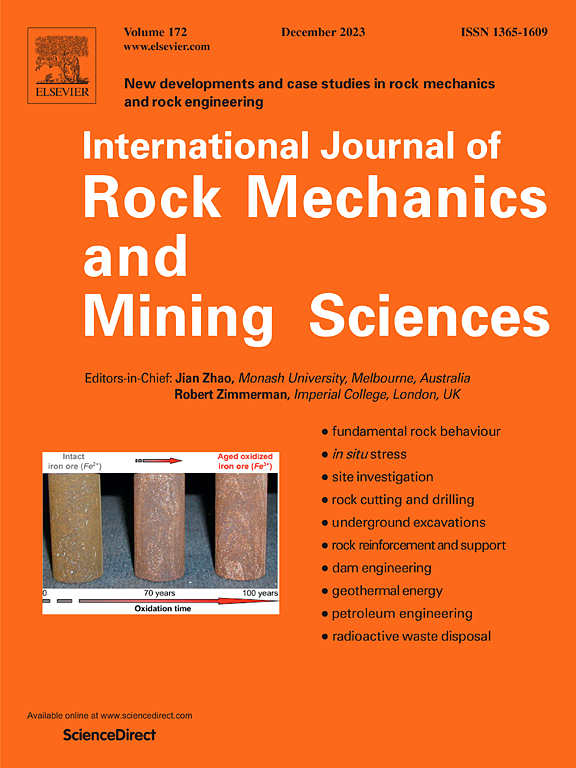开发和验证了一种用于地下采矿支护设计的新型刚性块建模方法,为提高安全性和效率提供了新的途径
IF 7.5
1区 工程技术
Q1 ENGINEERING, GEOLOGICAL
International Journal of Rock Mechanics and Mining Sciences
Pub Date : 2025-07-26
DOI:10.1016/j.ijrmms.2025.106220
引用次数: 0
摘要
支持系统对工人的安全至关重要,可以最大限度地减少因倒塌事故或需要修复而导致的生产延误。购买和安装支助装置也是任何地雷业务预算的一项重大费用。然而,目前的标准做法依赖于几十年前开发的经验方法或基于楔分析和关键块理论的岩体及其与支护系统相互作用的简化运动学模型。经验表明,这些设备缺乏当今采矿深度和安全需求所需的稳健性。更快的计算机处理器和新的数值模拟工具的出现使我们能够摆脱这些过于简化的方法,并采用能够更准确地模拟所遇到的破坏机制以及岩体与支撑元件之间相互作用的新方法。利用三维不同元素建模软件PFC3D,结合DFN模拟,开发了一种新的方法来评估Raglan矿山的支持系统策略。根据激光雷达扫描的超断数据对接头强度特性进行了校准。该研究证明了刚性块建模- dfn方法在模拟重力应力环境下复杂破坏机制方面的有效性。它为使用PM12和螺线杆#7之间的权衡提供了有价值的见解,以支持漂移的背部,以及确定在十字路口安装二次长支架的最佳时机。本文章由计算机程序翻译,如有差异,请以英文原文为准。
Development and validation of a Novel rigid block modelling approach for support design in underground mining, enabling new avenues for improved safety and efficiency
Support systems are vital for worker safety and to minimize production delays due to collapse incidents or the need for rehabilitation. The purchase of support elements and their installation also represent a significant cost for the operational budget of any mine. However, current standard practices rely on empirical methods developed several decades ago or on simplified kinematic models of the rock mass and its interaction with the support system based on wedge analysis and key-block theory. Experience shows that these lack the robustness required for today's mining depths and safety needs. The advent of faster computer processors and new numerical modelling tools allows us to move away from these over-simplified methodologies and embrace new approaches that can more accurately simulate the failure mechanisms encountered and interactions between the rock mass and the support elements. A new methodology using the 3D distinct-element modelling software PFC3D, combined with DFN simulations, was developed to evaluate support system strategies at the Raglan Mine. The joint strength properties were calibrated against overbreak data from lidar scans. The study demonstrated the effectiveness of the Rigid Block Modelling-DFN approach in simulating complex failure mechanisms in a gravitational stress environment. It provided valuable insights into the trade-offs between using PM12 and rebar #7 for supporting the backs of drifts, as well as determining the optimal timing for installing secondary long supports at intersections.
求助全文
通过发布文献求助,成功后即可免费获取论文全文。
去求助
来源期刊
CiteScore
14.00
自引率
5.60%
发文量
196
审稿时长
18 weeks
期刊介绍:
The International Journal of Rock Mechanics and Mining Sciences focuses on original research, new developments, site measurements, and case studies within the fields of rock mechanics and rock engineering. Serving as an international platform, it showcases high-quality papers addressing rock mechanics and the application of its principles and techniques in mining and civil engineering projects situated on or within rock masses. These projects encompass a wide range, including slopes, open-pit mines, quarries, shafts, tunnels, caverns, underground mines, metro systems, dams, hydro-electric stations, geothermal energy, petroleum engineering, and radioactive waste disposal. The journal welcomes submissions on various topics, with particular interest in theoretical advancements, analytical and numerical methods, rock testing, site investigation, and case studies.

 求助内容:
求助内容: 应助结果提醒方式:
应助结果提醒方式:


